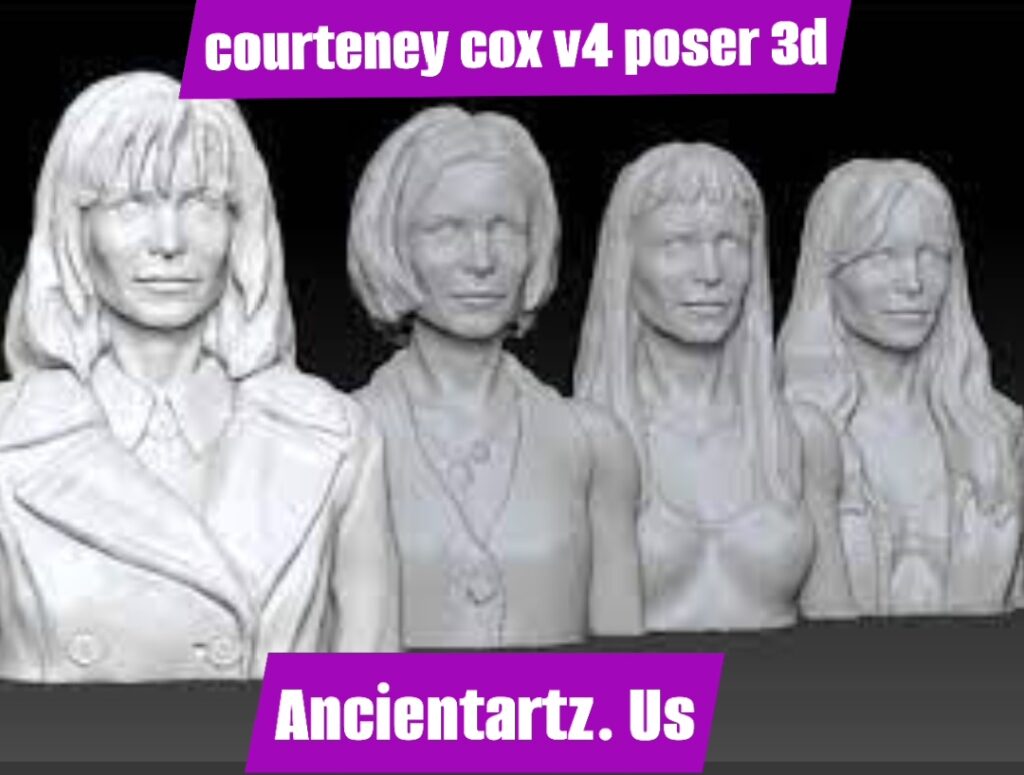Introduction
In the world of digital art and design, 3D modeling and rendering have revolutionized the way artists, filmmakers, game designers, and enthusiasts create visual representations of characters, scenes, and entire worlds. Among the numerous tools available to digital artists, Poser stands out as a significant software that has been pivotal in shaping the landscape of 3D character creation. One of the most fascinating aspects of Poser is its ability to allow users to create hyper-realistic human characters, including popular celebrity likenesses.
Courteney Cox V4 Poser 3D is one such creation that exemplifies the power and flexibility of Poser’s rendering engine. This digital model, inspired by the acclaimed actress Courteney Cox, best known for her iconic role as Monica Geller on the hit television show Friends, represents a detailed, lifelike 3D rendering of the star. The V4 in its name refers to the fourth version of Poser’s Victoria figure base, which is highly customizable and is used for a vast range of artistic creations. The model of Courteney Cox V4 is crafted to reflect both her physical appearance and the nuances of her persona. Artists and creators can manipulate this 3D model for various purposes, from animated short films to digital sculptures and game characters.
Creating a 3D representation of a real person, particularly a well-known celebrity like Courteney Cox, is no easy task. It requires an in-depth understanding of the nuances of the human form, texture, and expression. Using Poser 3D, artists can adjust and fine-tune facial features, body structure, skin textures, hair, and clothing to match the likeness of the individual. For example, Courteney Cox’s features, such as her facial structure, eye color, and distinctive hairstyle, need to be faithfully recreated with attention to detail in order to create a model that feels realistic and true to life.
The advent of 3D modeling has also opened up new possibilities for digital entertainment, including virtual reality (VR), augmented reality (AR), and video games. The ability to create hyper-realistic 3D models of real-life celebrities allows creators to experiment with different visual styles, storytelling approaches, and interactive environments. Whether used for cinematic purposes or in video game engines, 3D models like Courteney Cox V4 Poser 3D play a significant role in shaping the future of digital entertainment.
This article explores the creation and significance of Courteney Cox V4 Poser 3D, its impact on the digital art world, and the advanced techniques used in crafting such lifelike models. Additionally, we will delve into the role of Poser in character creation, the challenges faced by digital artists, and the future of 3D modeling in the entertainment industry.
The Evolution of 3D Modeling and Poser Software
The evolution of 3D modeling has gone hand in hand with advancements in computer graphics and rendering technology. In the early days of computer graphics, creating 3D representations was a cumbersome process, often requiring powerful hardware and complex programming. However, as software development advanced, tools emerged that simplified the process for artists and creators.
Poser, developed by Smith Micro Software, became one of the most widely recognized 3D character creation tools. Initially launched in the mid-1990s, Poser was designed to be an intuitive, user-friendly application that allowed users to easily create and manipulate 3D human characters. Over time, Poser evolved, with multiple versions released to improve the software’s capabilities, including better textures, more realistic physics, and enhanced rendering engines.
The Victoria 4 (V4) figure base, which Courteney Cox V4 is based on, was a pivotal moment for Poser. It introduced a highly detailed and flexible character rig that allowed users to sculpt and morph the figure into a variety of realistic and unique characters. This release gave artists the ability to push the boundaries of what was possible in 3D character modeling, and it became an industry-standard tool for creating characters for animation, games, and more.
With V4, Poser introduced several key features, including more detailed facial morphs, a wider range of body types, and an enhanced rigging system that made posing the characters more fluid and natural. These features were critical in enabling artists to create more realistic and expressive characters, which is why it has become such a popular choice for creating digital celebrity likenesses, like Courteney Cox V4 Poser 3D.
The Art of Likeness: Creating Courteney Cox in 3D
Creating a 3D model of a celebrity involves more than just replicating their physical features. Artists must capture the essence of the person, reflecting not just their appearance but also the subtleties of their expressions, movements, and unique qualities. When it comes to Courteney Cox V4, the goal is to produce a character that feels authentic and true to life while remaining flexible enough for various artistic interpretations.
The first step in crafting Courteney Cox V4 Poser 3D is capturing her likeness in a highly detailed way. This process begins with photorealistic textures—a key feature in making 3D characters look lifelike. Artists often use high-quality reference photos from various angles to ensure accuracy in skin tone, hair color, and facial features. In the case of Courteney Cox, her smooth complexion, dark brown hair, and almond-shaped eyes are key elements that must be recreated with precision.
The next challenge is replicating the expressive nature of Courteney Cox’s face. This involves sculpting and refining the facial structure to accommodate various expressions. Poser allows artists to adjust the 3D model’s facial morphs to create smiles, frowns, or other subtle emotional cues. Capturing these nuances is essential for making the character feel truly alive.
Moreover, artists also need to account for movement and posing. 3D models are often used in animations or static poses, so it’s important that the rigging system allows for fluid movement. Poser’s V4 figure base provides a high level of articulation and flexibility, allowing artists to create dynamic poses that match the personality of the character. Whether it’s Courteney Cox’s recognizable stance in Friends or her more dramatic expressions in other roles, the rig must support these motions realistically.
Technical Aspects of Creating Realistic 3D Models in Poser
To truly understand the process of creating a 3D model like Courteney Cox V4 Poser 3D, one must delve into the technical aspects of the software. While artistry and creativity are at the forefront, the tools and techniques used in 3D modeling are equally important in achieving photorealism.
One of the most important tools in Poser is the morphing system. Morphs are predefined alterations that can be applied to the model to adjust its shape or features. For example, morphs can be used to change the shape of the nose, the curve of the jawline, or the position of the eyes to make the model resemble Courteney Cox more closely. By combining different morphs, artists can fine-tune every detail of the model.
Another essential feature is texture mapping. This process involves wrapping 2D textures onto the 3D model in a way that mimics the appearance of real-world materials. For example, creating the skin texture of Courteney Cox involves intricate work to ensure the skin appears smooth and realistic, with appropriate lighting and shading effects. Artists often use high-resolution texture maps, as well as bump and normal maps, to give the skin depth and detail.
Lighting plays a critical role in enhancing the realism of a 3D model. Proper lighting can make or break the look of a character, as it affects how textures, shadows, and colors interact with each other. In Poser, artists can experiment with different lighting setups to simulate various environments, from soft, natural light to dramatic, studio-style lighting.
The Future of 3D Modeling and Digital Celebrities
The rise of digital modeling and rendering technologies continues to shape the future of entertainment, advertising, and digital art. As software like Poser becomes more advanced, artists can expect even more lifelike and complex digital characters to be created, not only of celebrities like Courteney Cox V4 but of original characters as well.
In the realm of virtual reality (VR) and augmented reality (AR), 3D models are becoming integral to immersive experiences. Imagine stepping into a VR world where you can interact with hyper-realistic versions of real-life figures, or using AR to see digital versions of celebrities in your own living room. The possibilities are endless.
Furthermore, motion capture technology is allowing for more dynamic and realistic movement of 3D characters. Motion capture, or mocap, involves recording real human movements and applying them to 3D models. This process has already been used in films and video games, and as it becomes more accessible, we can expect to see even more realistic animations and performances from 3D characters.
Conclusion
The world of Courteney Cox V4 Poser 3D serves as a testament to the incredible potential of 3D modeling in the digital age. What started as a tool for artists to create basic human figures has evolved into a powerful platform for creating lifelike digital versions of celebrities and entirely new characters. With its user-friendly interface and advanced features, Poser has empowered a new generation of artists to push the boundaries of digital art.
The creation of Courteney Cox V4 Poser 3D highlights the intricate process of combining artistic talent with technical expertise. From capturing the likeness of the actress to adjusting every facial feature and texture to perfection, every step in the process is a blend of creativity and precision. The ability to manipulate the model’s body, face, and expressions allows for endless possibilities, enabling artists to create scenes, animations, and digital art that was once considered unimaginable.
In addition to the artistic value, the Courteney Cox V4 Poser 3D model also represents the growing importance of digital celebrities in the entertainment industry. Whether it’s for use in video games, films, or virtual reality experiences, digital versions of real-life figures are becoming an increasingly common and valuable tool. As technology continues to advance, we can expect digital recreations of celebrities to become even more immersive and lifelike.
Looking ahead, the future of 3D modeling holds exciting possibilities. With continued advancements in AI, machine learning, and rendering technologies, the creation of hyper-realistic characters will become more accessible and efficient. The lines between the physical and digital worlds will continue to blur, offering new opportunities for creators, audiences, and consumers to engage with entertainment in innovative ways.
FAQs
1. What is Poser software, and how is it used in creating 3D characters?
Poser is a 3D character creation software that allows users to model, animate, and render human and animal figures. It is widely used by digital artists to create realistic characters for animation, video games, and visual art. Artists can manipulate figures, adjust textures, and fine-tune facial expressions to create lifelike representations of people.
2. What makes Courteney Cox V4 Poser 3D unique?
The Courteney Cox V4 Poser 3D model is a highly detailed and realistic digital replica of the actress Courteney Cox. Using Poser’s advanced morphing and texture mapping tools, artists have recreated her physical likeness with exceptional precision. This model can be used for various artistic purposes, from static images to dynamic animations.
3. Can I use Poser to create my own 3D character models?
Yes, Poser is designed to be accessible to both beginners and professionals. With its pre-built figure bases like Victoria 4, you can create your own characters by adjusting the body, facial features, and textures to match your vision. Poser also offers extensive customization options, making it a versatile tool for character creation.
4. How does Poser’s rendering system enhance the realism of 3D models?
Poser’s rendering engine allows artists to create realistic images by simulating lighting, textures, and materials. The software supports advanced techniques like ray tracing and global illumination, which help produce photorealistic results. These features, combined with detailed textures and realistic physics, make the rendered models appear lifelike.
Also Read This: Courteney Cox V4 Poser 3D: Exploring the Depths of Digital Art Creation and Realism



